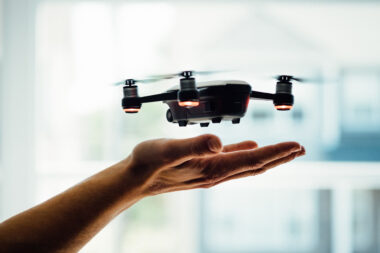In the vast landscape of robotics, a fascinating frontier is unfolding at the smallest scales imaginable micro and nano robotics. These miniature marvels, measuring mere micrometers to nanometers, are opening new avenues for exploration, manipulation, and intervention in domains ranging from healthcare to manufacturing.
Micro- and nano-robotics represent a groundbreaking field at the intersection of robotics, materials science, and nanotechnology. These miniature machines, with dimensions ranging from micrometers to nanometers, offer unprecedented opportunities for exploration and intervention at the smallest scales imaginable. Unlike their macroscopic counterparts, micro- and nano-robots must contend with unique challenges stemming from scale effects, surface interactions, and energy constraints. Understanding and harnessing these challenges are crucial for unlocking the full potential of micro- and nano-robotics in domains such as healthcare, manufacturing, and environmental monitoring.
Design Principles and Fabrication Techniques:
Designing and fabricating micro- and nano-robots require innovative approaches tailored to the challenges of working at such minuscule scales. Researchers draw inspiration from nature, where microorganisms exhibit remarkable capabilities for propulsion and locomotion. Fabrication techniques such as lithography, 3D printing, self-assembly, and biofabrication enable the creation of intricate structures with sub-micron precision and resolution. These techniques empower researchers to design and build micro- and nano-robots with diverse functionalities, from simple locomotion to complex manipulation and sensing.
Propulsion and Locomotion:
Propelling micro- and nano-robots through fluidic environments presents a formidable engineering challenge due to the dominance of viscous forces and the absence of inertial effects at small scales. Various propulsion mechanisms have been explored, including flagella-like helical tails inspired by bacteria, cilia-inspired beating structures mimicking microorganisms, and electrochemical actuators leveraging chemical reactions for motion. Locomotion strategies range from simple rolling and sliding motions suitable for flat surfaces to more complex swimming and crawling behaviors optimized for navigating complex environments. By harnessing these propulsion and locomotion principles, researchers aim to develop micro- and nano-robots capable of performing tasks with unprecedented precision and agility in diverse real-world scenarios.
Applications of Micro- and Nano-Robotics:
Micro- and nano-robots hold promise for a wide range of applications across multiple domains:
Biomedical Applications:
– Targeted Drug Delivery: Micro- and nano-robots can navigate through the bloodstream to deliver drugs with high precision to target sites within the body, minimizing side effects and improving therapeutic outcomes.
– Minimally Invasive Surgery: Nano-scale robots equipped with sensors and actuators can perform minimally invasive procedures inside the body, offering greater precision and control than traditional surgical techniques.
– Cell Manipulation: Micro-robots can manipulate individual cells or perform complex operations at the cellular level, opening new possibilities for research, diagnostics, and regenerative medicine.
Environmental Monitoring and Remediation:
– Water Quality Monitoring: Nano-robots equipped with sensors can detect and monitor pollutants in water sources, providing real-time data for environmental monitoring and remediation efforts.
– Oil Spill Cleanup: Micro-scale robots can be deployed to clean up oil spills by absorbing or dispersing oil contaminants, mitigating environmental damage and protecting aquatic ecosystems.
Manufacturing and Automation:
– Micro-Assembly: Nano-robots can assemble micro-scale components with high precision, enabling the fabrication of complex structures and devices for electronics, photonics, and MEMS (Micro-Electro-Mechanical Systems).
– Quality Control: Micro-robots equipped with sensors and cameras can inspect and evaluate manufactured components at the micro-scale, ensuring quality control and defect detection in industrial processes.
Hardware Required for Micro- and Nano-Robotics:
Microfabrication Equipment: Specialized microfabrication tools such as photolithography systems, electron beam lithography (EBL) systems, and focused ion beam (FIB) machines are essential for creating micro- and nano-scale structures with high precision.
Nanoimprint Lithography (NIL) Tools: Nanoimprint lithography enables the replication of nanoscale patterns onto substrates using molds or stamps. Nanoimprint tools, including thermal and UV nanoimprint systems, are critical for fabricating nanostructures with high throughput and resolution.
Atomic Force Microscopes (AFMs): AFMs are indispensable tools for imaging, manipulating, and characterizing materials at the nanoscale. They provide high-resolution images and enable precise manipulation of nano-objects for assembly and fabrication purposes.
Scanning Electron Microscopes (SEM): SEMs are used for imaging and analyzing the surfaces of micro- and nano-structures. They offer high-resolution imaging capabilities and are essential for inspecting fabricated devices and verifying their dimensions and features.
Microfluidic Devices: Microfluidic systems facilitate the manipulation and control of fluids at the microscale, enabling applications such as drug delivery, chemical synthesis, and cell analysis. Microfluidic devices are integral components of many micro- and nano-robotic systems for handling fluids and performing tasks in miniature environments.
Software Required for Micro- and Nano-Robotics:
Computer-Aided Design (CAD) Software: CAD software allows designers to create precise digital models of micro- and nano-robotic devices, including their mechanical structures, electrical components, and fluidic systems. Popular CAD tools such as SolidWorks, AutoCAD, and Fusion 360 are used for designing robotic components and assemblies.
Simulation Software: Simulation software enables researchers to model and simulate the behavior of micro- and nano-robots under various operating conditions. Finite element analysis (FEA) software, computational fluid dynamics (CFD) software, and multi-physics simulation tools provide insights into the mechanical, thermal, and fluidic behaviors of robotic systems.
Control and Programming Tools: Programming environments and software libraries are essential for developing control algorithms and software interfaces for micro- and nano-robots. Languages such as C/C++, Python, and MATLAB are commonly used for coding control algorithms, while robotics frameworks like ROS (Robot Operating System) provide a platform for integrating hardware components and implementing complex robotic behaviors.
Image Processing Software: Image processing software is used for analyzing and interpreting data acquired from microscopy and imaging systems. Software packages such as ImageJ, MATLAB Image Processing Toolbox, and OpenCV offer tools for image enhancement, segmentation, feature extraction, and quantitative analysis in micro- and nano-robotic applications.
CAD-to-Fabrication Software: CAD-to-fabrication software tools facilitate the translation of digital designs into instructions for microfabrication and nanofabrication processes. These tools generate machine-readable files compatible with microfabrication equipment, ensuring accurate replication of design features on substrates and devices.
Challenges and Future Directions:
Despite their immense potential, micro- and nano-robotics face several challenges that must be addressed for widespread adoption:
– Power and Energy: Powering micro- and nano-robots remains a significant challenge, as conventional energy sources are often impractical at such small scales. Researchers are exploring alternative energy harvesting methods, such as light, vibration, and chemical reactions, to power these miniature machines.
– Control and Navigation: Controlling the motion and behavior of micro- and nano-robots in complex environments poses significant challenges due to scale effects, fluidic interactions, and limited sensing capabilities. Developing robust control algorithms and navigation strategies is essential for realizing the full potential of these tiny robots.
– Biocompatibility and Safety: In biomedical applications, ensuring the biocompatibility and safety of micro- and nano-robots is crucial to prevent adverse reactions and ensure patient safety. Researchers are investigating novel materials and fabrication techniques to minimize toxicity and enhance biocompatibility.
Micro- and nano-robotics represent a frontier of exploration and innovation, offering unprecedented capabilities for manipulation and intervention at the smallest scales. As researchers continue to push the boundaries of fabrication, propulsion, and control, the potential applications of these miniature machines are boundless, from revolutionizing healthcare and manufacturing to safeguarding the environment and exploring new frontiers of science and technology. With continued investment and collaboration across disciplines, micro- and nano-robotics are poised to shape the future of robotics and unlock new possibilities for human ingenuity and exploration.



